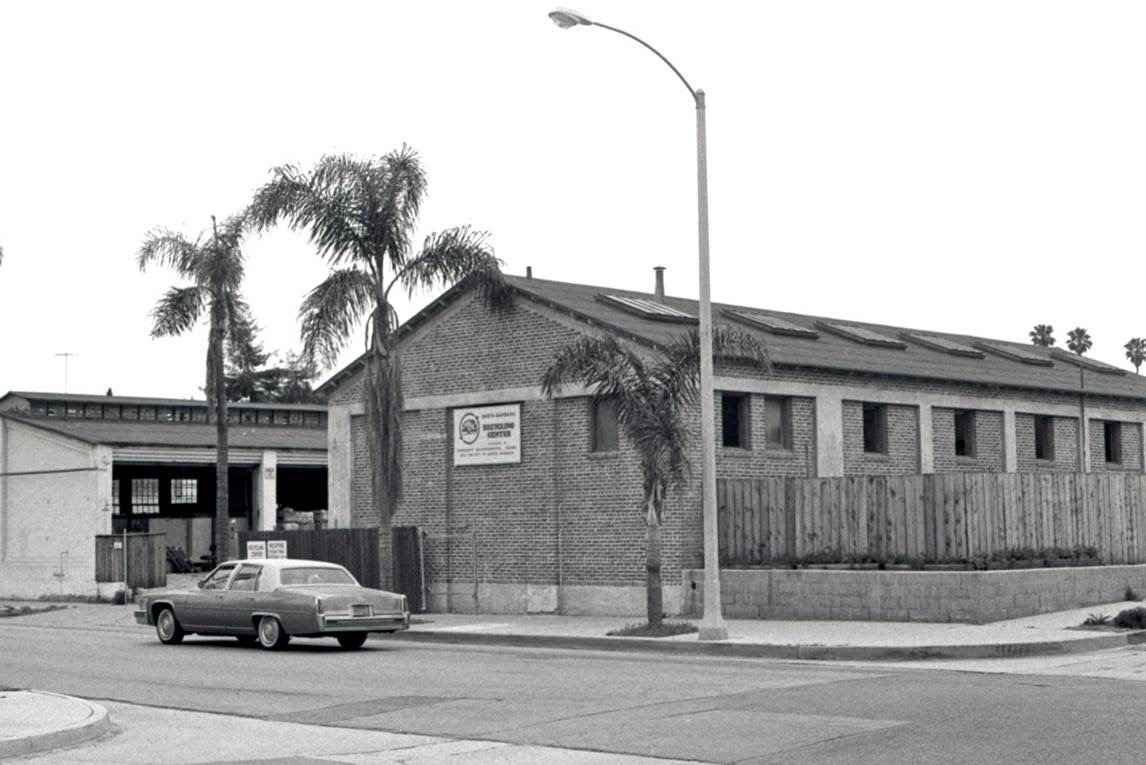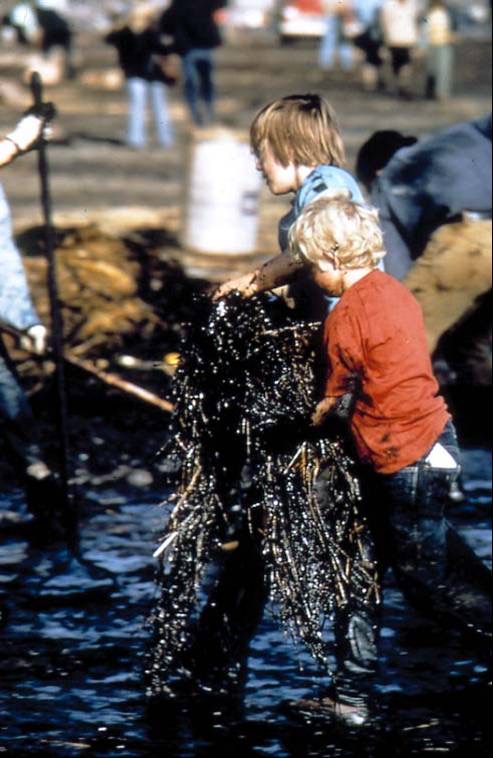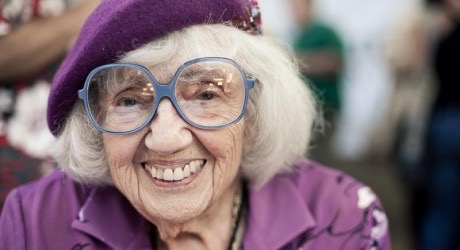Earth Day 50

Looking Back / Looking Forward
Santa Barbara is often referred to as the “birthplace of the Environmental Movement.” It is true that back on April 22, 1970, Santa Barbara had become a key catalyst for the first Earth Day, having galvanized public outrage a year earlier when it experienced the worst oil spill in U.S. history on January 28, 1969.
That environmental disaster led to a movement spearheaded by Gaylord Nelson, a U.S. Senator from Wisconsin, who sought to awaken the nation to the assault on the environment that he predicted would undermine not only our economy, but ultimately the ability of the earth to compensate for the sins of greed that were grinding away at every corner of our civilization. Nelson persuaded Pete McCloskey, a conservation-minded Republican Congressman from California, to join him as a national co-chair of the first Earth Day. They then recruited Denis Hayes, a 25-year-old Harvard student, to organize a national event that ultimately resulted in 20,000,000 people joining the movement across the country.
The infamous Santa Barbara Oil Spill that had occurred a year earlier wasn’t the only thing that gave rise to Earth Day. Thirty days before the spill, the Apollo 8 astronauts who were preparing the way for the July, 1969 landing on the lunar surface, found themselves on a trial mission that made one of the first orbits around the moon. It was almost by accident, but they took a picture of earth as they emerged for the first time from the dark side of the moon. This “earth rise” image captivated international attention as everyone on our planet saw this glistening and magnificent orb in space for the first time. What a remarkable place, they observed, “seeing all three billion inhabitants of our home living together against the dark vastness of space.”

Now 50 years later, that glistening sphere has more than doubled in population to 7.2 billion people. Can the earth survive such a population assault? What have we learned in 50 years, and where do we still need to go?
I never expected to stay in Santa Barbara as I was getting out of college at the time of the first Earth Day, but that catalytic event transformed my life as well. Emerging out of the first celebration was a community ready to organize to stop the destruction of our own local environment. A “community environmental council” (CEC) was formed to bring people together, led by a young college student named Paul Relis. Within a short period of time, I was asked to become his Co-Director of this fledgling organization, and together we sought out opportunities to change the world. We wanted to created positive replicable models that would take hold, rather than just fighting against the status quo.
Over the next ten years, we told stories about how bad the world might become without concerted acts of stewardship. It is interesting to look back on the predictions we made and to see what did, or did not, happen. For instance, we were convinced that 30 years in the future, the world would run out of oil by the year 2000. If we didn’t get on with building alternative transportation, the economy of our planet would grind to a halt. Well, that now makes for a good laugh!
On the other hand, we launched the City/County Recycling Program in 1974, and our community pitch was that if we all saved wasted resources through “reducing, reusing, and recycling” our paper, cans, and bottles, we could divert 5% of the waste stream by 1980. Looking way out into the future, we suggested that by 1990 we could divert 25% of our throwaways, and way out in the year 2000 we could reach 50% diversion. None of us really knew whether or not this was possible, but it turned out that by the year 2012 Californians were diverting, recycling, and reusing two-thirds (66%) of the waste that we used to burn or bury in landfills! What we did in Santa Barbara became the template for changing recycling laws throughout the country.
All of that environmental enthusiasm had a remarkable impact on the people of Santa Barbara, sparking an outpouring of good work. In my own life, it got me elected to the City Council, then Mayor, and also President of the California League of Cities, Vice President of the National League of Cities in Washington, D.C., and President of the Institute for Local Government in Sacramento. For someone who knew little about politics, it was a total surprise that my life took such a turn.
Even though I would like to say that enlightened political leadership led us to a brighter tomorrow, the real story is that it was an army of somewhat novel, eccentric, and creative citizens who led the way and changed the planet’s future. As remarkable a place as Santa Barbara is, you could list double-spaced on a 3×5 card the number of local elected officials that changed Santa Barbara’s stewardship agenda.
So, who did change our local environment since the first Earth Day? Here is my short list of Ten Environmental Legacies that shaped our world since 1970 – and, the Pioneers that made it happen:
1. Establishment of the California Coastal Commission
Voted into existence by a statewide vote in 1972, the law preserved the coastline for enjoyment of future generations. Intensive beachfront development came to a halt, and the citizens were put in charge of the stewardship of the coast. No one helped shape this effort more that the longtime Chair of the Commission, Santa Barbara County First District Supervisor, Naomi Schwartz. Her fearless leadership assured a pattern of conservation that has lasted through five decades.
2. Instituted Recycling as a Fact of Life in the U.S.
Bob Klausner and his wife, Betty, had relocated to Montecito just after the oil spill, but he put his business mentorship to work, and joined me at CEC to move recycling from a volunteer Boy Scout exercise, to a thriving business. I learned more from Bob in five years than most people do in a lifetime! He was the consummate volunteer.

He began in 1974 by convincing the President of the Garden State Paper Co. in New Jersey to give CEC an exclusive contract for recycled paper that weathered any downturn in the economy. In 1975 we started 40 neighborhood pickup routes with college students, and offered cash back to over 400 nonprofit organizations if they would deliver paper to the Recycling Center which we convinced the City to let us build at Garden and Ortega Streets. By 1976, we held the first National Recycling Congress at the Miramar Hotel in Montecito, and convinced the State Legislature in 1978 to put together millions of dollars of grants to help building recycling facilities throughout California.
Nothing, though, topped what Bob did with the military. In 1977 Bob and I drove up to visit the Base Commander at Vandenberg AFB to talk him into joining our countywide effort. What the Commander told us would have stopped me in our tracks, but Bob was undeterred. The Commander told us that the Defense Disposal Act of Congress prohibited his giving us an exclusive contract and that every load of recyclables would have to be put out to bid. So, Bob went to the Defense Disposal Agency in Michigan, then the Corp. of Engineers in New Orleans, and finally we stood in the Office of the Secretary of Defense at the Pentagon, and Bob convinced him that this was in the interest of our national defense! Low, and behold, CEC was given on the spot the ONLY exemption to this Act of Congress!

Two weeks later a van load of military brass descended on the Santa Barbara Recycling Center trying to figure out who we were! Within a month we had a new Center next to the Vandenberg AFB runway and we were in business! Within five years, our model program became a national model for the military and was enacted into law and required at every base in the country.
3. Fought to make Land Conservancy a Priority

The land development rush of the 1960s gave way to the preservation of open space. Six months after the first Earth Day when the 3,638-acre El Capitan Ranch on the Gaviota Coast was proposed for a development of 1,500 homes, the citizenry rose up in a protest that could be heard all the way to Sacramento. Selma Rubin, who over the years became the matriarch to many citizen organizations in Santa Barbara, took on the developers in a landmark legal case that brought the development to a complete collapse. For the next 30 years the battle over land conservation raged on, and Selma was a front row leader in every battle.
Today, thanks to the efforts of Chuck Blitz and Roger Himovitz, the new owners of El Capitan Ranch, over 3,000 acres are set aside in perpetuity as a preserve. Parallel to this battle, Sue and Jim Higman led an army of volunteers to ultimately saved the 92-acre Wilcox Property (now the Douglas Family Preserve) after 10 years of battle. Also preserved were the 150-acre Jesuit Property (now part of Elings Park), and at least six other major land holdings representing thousands of acres were saved as open space for generations to come.
4. Citizens Used the Law to Fight for the Environment
It wasn’t long after the oil spill that Bud Bottoms and a host of activists formed Get Oil Out (GOO) to fight the oil interests that had blackened our beaches. Their work continues to this day. A significant legal consortium also emerged a few years later under the leadership of a young attorney named Mark McGinnes. Mark used his legal skills to form the Environmental Defense Center, and brought together a young army of committed attorneys to fight to free the coastline from the ravages of energy development. Today, they are one of the most respected environmental organizations in the state with a string of landmark decisions under their direction.

5. Made California’s Energy Conservation the Strongest in the Nation
By 1976, it was clear that we couldn’t just oppose energy development, we needed to reduce our dependency on energy. In January of 1976, the City of Santa Barbara hired the CEC to review and recommend to the city how to reduce its energy use. The City Manager was opposed, claiming that everything that could be done, had been done. Six months later, we presented our findings to the City showing how they could reduce their energy use by 25% – and, gave them a refund check for over $50,000 for overpayments they had made to Southern California Edison. As a result, the Council fired the City Administrator, and I was asked to run for the City Council.
Meanwhile, under the leadership of Jerry Brown, the new Governor of California, the state instituted one of the strongest energy use standards for new construction in the United States. Today, 50 years later, the per capita use of energy in California is 50% below the average of the other 49 states.
6. Cleaned California’s Air with Alternative-Fueled cars
One of Governor Brown’s stellar appointments was Mary Nichols as the Director of the California Air Resources Board. No other state had an official department dedicated to cleaning up the air of an entire state. Mary’s stunning achievements changed the automobile standards statewide, and reduced air pollution in a way never thought possible at the time of the first Earth Day. By 2020, California has thousands of electric vehicles on the road, car companies such as Toyota have over a million hybrid Prius vehicles selling like hotcakes, and eleven auto companies are producing hydrogen-fueled experimental cars. Back in Santa Barbara, CEC’s Green Car Show held annually on Earth Day is the biggest of its kind in the nation.
7. Set the Standards for Cleaning the Oceans
Santa Barbara’s Bob Sulnick, along with actor Ted Danson, formed the American Oceans Campaigns in the 1980s, focusing on global attempts to reduce the pollution of the seas. Another local hero, Hillary Hauser, provided the leadership for the Heal the Ocean organization. Both groups have obtained significant help from the Hollywood community to publicize the destruction of the oceans.
8. Galvanized Community Support to Save the Waterfront
In 1924, a number of citizens banded together to try to save the Santa Barbara waterfront from becoming another Miami Beach with wall-to-wall hotels. Led by Pearl Chase, the consummate champion of civic activism, they managed to save East Beach from over development, and the citizens voted to preserve the waterfront and park lands now known as Chase Palm Park.

Fifty years later, history repeated itself. Paul Relis and Robert Easton formed the Committee for Santa Barbara to stop Southern Pacific Railroad from making a deal with the Santa Barbara City Council to build a 1,000-room hotel where Chase Palm Park is today, and to reroute Cabrillo Boulevard behind the development. The Committee for S.B. met weekly and drew together dozens of people who fought for five years to stop the project in its many forms that kept emerging. In the end, the actor Fess Parker bought out the railroad’s interest in the land and made a deal with the City to dedicate half of the land as an extension of Chase Palm Park on the northside of the street as extra park land.
9. Established California as the Leader in Renewable Energy
John Bryson who lives part time in Carpinteria, became one of Governor Jerry Brown’s youngest appointees chosen to make his environmental mark. In his twenties, Bryson was one of the founders of the National Resources Defense Council. At age 32, Governor Brown appointed him to be the head of the State Water Resources Control Board. Four years later, the Governor appointed him to be the Chair of the Public Utilities Commission. Five years later, Bryson joined Southern California Edison as a V.P., and by the time his career there ended, he was Chairman of the Board of Edison International. More than anyone else in the 1990s, he steered Edison to become the largest proponent of renewable energy in the world, far exceeding the state or national goals and requirements.
10. Established the UCSB Bren School as the Premier Environmental School in the Nation
Before teaching about the environmental crisis became fashionable, numerous local luminaries began teaching classes at UCSB based on the lessons learned following the 1969 oil spill. UCSB took a major step forward with the help of a donation from Donald Bren of the Irvine Corporation. Now, the Bren School for Environmental Science and Management led by Dean Steve Gaines, Ph.D. has become one of the premier graduate schools in the world preparing students to become catalytic forces for change, ranging from the protection of nature to the scientific and social changes needed to transform our economy for a sustainable future.
So, where do we go next?
Climate Change is the biggest challenge facing our global community. Not only is it an environmental crisis, but it is also devastating the local crops and economy of most 3rd world cultures. Without a concerted effort to reverse this trend, within 50 years we will see the extinction of thousands of species of plants and animals. We will also face an economic and social pandemic that will pit rich countries against poor ones, and vast migrations of immigrants will flood the countries that still will have resources.
In the March issue of “O” Magazine, Oprah Winfrey, one of Montecito’s most noted spokespeople, says: “The environment is the thing she values most in life.” Like Oprah, most of us marvel that we are so lucky to live in a place where the environment is a God-given gift. So, what are Santa Barbarans doing today that can make a global difference in preserving this remarkable gift?
The continued environmental stewardship work by hundreds of people in our community provides gratifying hope. I have been particularly struck by the need to transform our purchasing patterns and power to make sure that our economy is not only sustainable, but that it contributes, rather than depletes, our natural resources. Like the Dust Bowl in the 1930s we need a revolutionary change in the way we farm our economic resources.
I am strongly supportive of the partnership between UCSB’s Bren School, the “green certifiers” of products in the U.S., the Environmental Media Association in Hollywood, and the Sacramento-based Institute for Local Government to develop a significant database of sustainable products that we can all buy as a substitute for products that deplete our natural resources. The GreenChoice Data (GCD) group, based in Santa Barbara, has reached out to the most credible product certifiers in the country to become partners. The project headed by Gary Petersen, along with their work with the UCSB Bren School, has created a significant step forward in achieving this goal. Thanks goes to the Wells Fargo Foundation who made a significant contribution, and to the high-level support of the State of California.
The CDG group is currently seeking funders to expand their work to tie the data base to a credit card that will give every consumer the ability to scan products in a store and determine their sustainability rating, with rewards for purchasing green products.
We can make the economy greener millions of purchases at a time. South Korea has tried this path and they now have over 18,000,000 green credit card holders in a country with a population slightly larger than California. We cannot predict the future accurately, but we do know that the location that sparked the first Earth Day is still the hotbed of environmental protection and hope.







